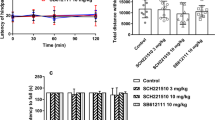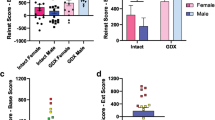Abstract.
Rationale: Recent studies indicate that morphine is more potent as an antinociceptive agent in male than female rodents and monkeys. Objectives: To evaluate the influence of sex, nociceptive stimulus intensity and an opioid's relative efficacy on opioid-induced antinociception in rat strains (F344 and Lewis) that display differential sensitivity to morphine antinociception. Methods: Antinociceptive testing was conducted using a rat warm-water (50–56°C) tail-withdrawal procedure. Dose–response and time-course determinations were performed with various opioids. Results: Across the nociceptive stimulus intensities tested, the high-efficacy µ opioids morphine, etorphine, and levorphanol were equally effective in males and females, but on average 2.5-fold more potent in males. At moderate stimulus intensities, the low-efficacy µ opioid buprenorphine was approximately 0.4-fold more potent in males, and at higher stimulus intensities more potent and effective (greater maximal effect) in males. At low stimulus intensities, the low-efficacy µ opioid dezocine and the µ/κ opioid butorphanol were greater than 8.9-fold more potent in males, and at moderate stimulus intensities were more potent and effective in males. At a low stimulus intensity, the µ/κ opioid nalbuphine was more potent and effective in males. At stimulus intensities in which buprenorphine, dezocine, butorphanol, and nalbuphine produced maximal effects in males but not females, these opioids antagonized the effects of morphine in females. Genotype-related differences were noted as opioids were generally more potent in F344 than Lewis males, whereas no consistent differences were observed between F344 and Lewis females. Conclusions: That sex differences in the potency and effectiveness of opioids increased with decreases in the opioid's relative efficacy and with increases in the nociceptive stimulus intensity suggests that the relative efficacy of µ opioids as antinociceptive agents is greater in male than female rats.
Similar content being viewed by others
Author information
Authors and Affiliations
Additional information
Electronic Publication
Rights and permissions
About this article
Cite this article
Cook, C., Barrett, A., Roach, E. et al. Sex-related differences in the antinociceptive effects of opioids: importance of rat genotype, nociceptive stimulus intensity, and efficacy at the µ opioid receptor. Psychopharmacology 150, 430–442 (2000). https://doi.org/10.1007/s002130000453
Received:
Accepted:
Issue Date:
DOI: https://doi.org/10.1007/s002130000453




